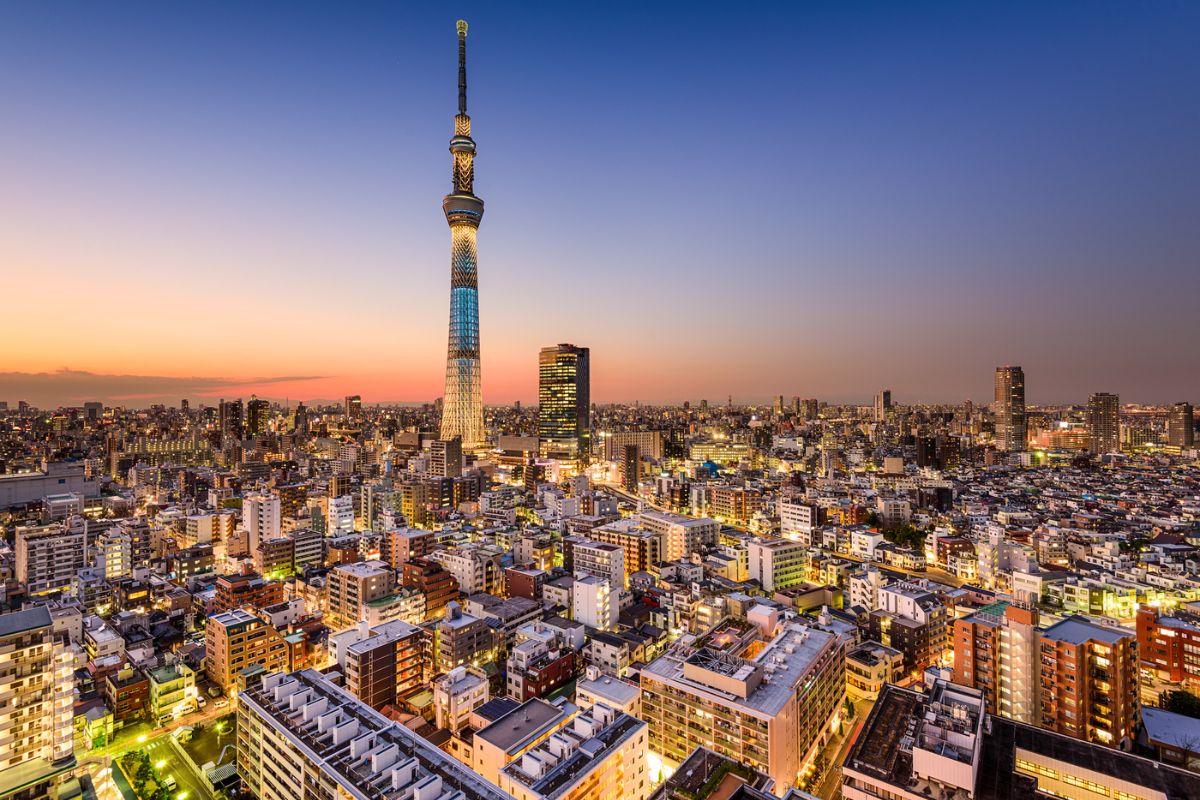Have you ever stood on top of the world while looking down at one of the largest and busiest cities? Tokyo Skytree offers this stunning experience and so much more.
Since 2012, Tokyo Skytree has been a hit with tourists and locals, welcoming over 10,000 visitors daily. It’s Tokyo’s highest and most popular observatory, but does it live up to the hype?
After visiting Tokyo Tower last year, I was sceptical that Tokyo Skytree could offer something different. But the views from the top are so incredibly high that they were awe-inspiring, when I first entered the observatory and approached the floor-to-ceiling windows.
In this article, I will review the entire Tokyo Skytree experience, discuss the pros and cons, offer information on buying tickets, examine what else is in the area, and offer tips and advice for visitors. I’ll conclude by recommending whether Tokyo Skytree is worth visiting or whether you should stick to a different observatory on your Tokyo itinerary.
Disclaimer: This article contains affiliate links. If you book after clicking on one of these links then we may receive a small commission at no extra cost to you.
- Check out the views from the tallest building in Japan.
- See the Tokyo cityscape from a perspective that no other tower can offer.
- Lots of different ticket options available.
What is Tokyo Skytree?
Tokyo Skytree was built as the main radio and television broadcast station for Tokyo and the entire Kanto region. Construction was completed on 29 February 2012, and it opened to the public on 22 May 2012.
The Tokyo Skytree is not only the tallest tower in Japan but also the tallest tower in the world. At an impressive 634 meters (2080 feet), it is also the fifth tallest structure in the world. The Burj Khalifa is definitely taller than the Tokyo Skytree, but it’s considered a skyscraper, not a tower.
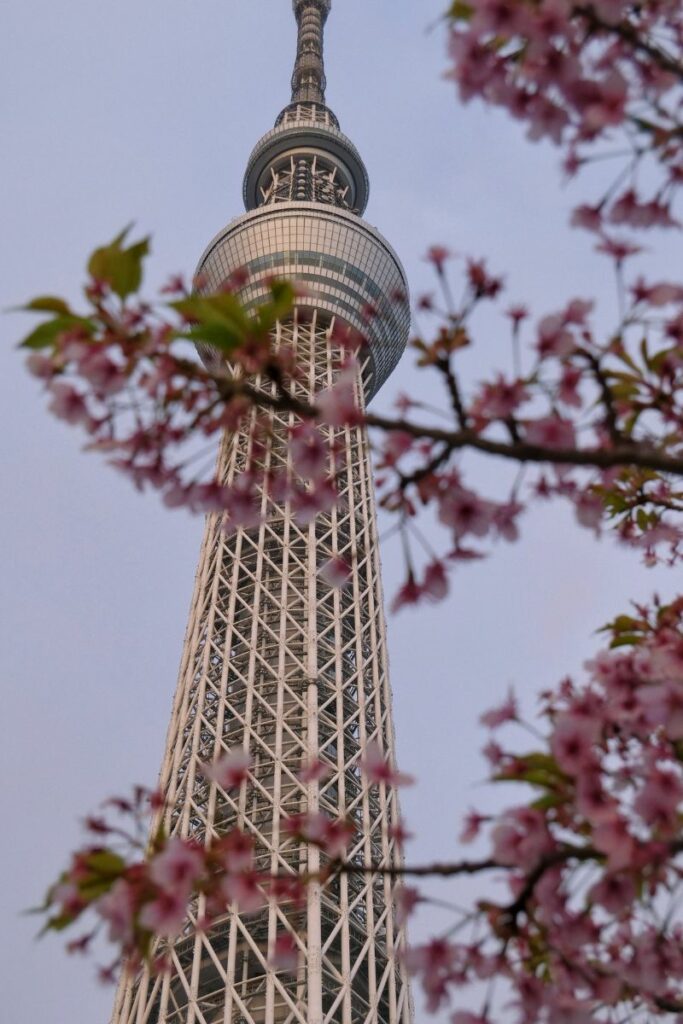
The designers chose a height of 634 meters because it is easily remembered in Japanese. The numbers 6 (mu), 3 (sa), and 4 (shi) spell out Musashi, the old name for the region where the Tokyo Skytree is located.
The Tokyo Tower is 333 meters (1092 feet) high, which means the Tokyo Skytree is almost double that height.
The Tokyo Skytree has two observation decks. The first one is 350 meters (1150 feet) high and can hold up to 2000 people. The highest observatory is 450 meters (1480 feet) high and can hold 900 people.
During the first week of Tokyo Skytree’s opening to the public, it welcomed 1.6 million visitors. On average, over 4 million people ascend the Tokyo Skytree elevators yearly.
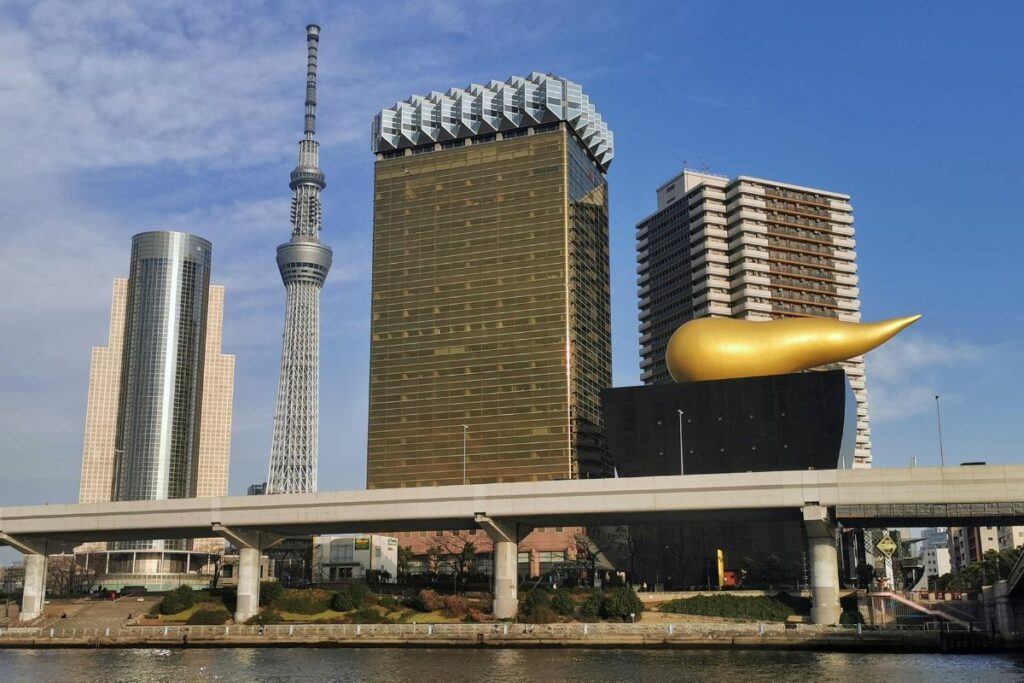
Why Visit Tokyo Skytree
Tokyo Skytree is one of the most iconic structures in Japan. Many visitors flock to this tower yearly, but some people might enjoy a visit more than others.
- Height Enthusiasts: When visiting Japan, there is no taller structure to get spectacular bird’s-eye views of the city.
- Photography and Social Media Fans: There are chances to capture some stunning photographs and unique social media pictures.
- Families with Children: A visit to Skytree makes a fun day out. Children will love the views and the cute Skytree mascots.
- General Tourists and Travellers: This experience offers tourists a fun day for their holiday and a different experience from Japanese temples and shrines.
- Repeat Visitors to Tokyo: Tokyo has numerous observation decks, each offering a completely different view. For example, if you have tried Tokyo Tower, you will have a different experience at Tokyo Skytree.
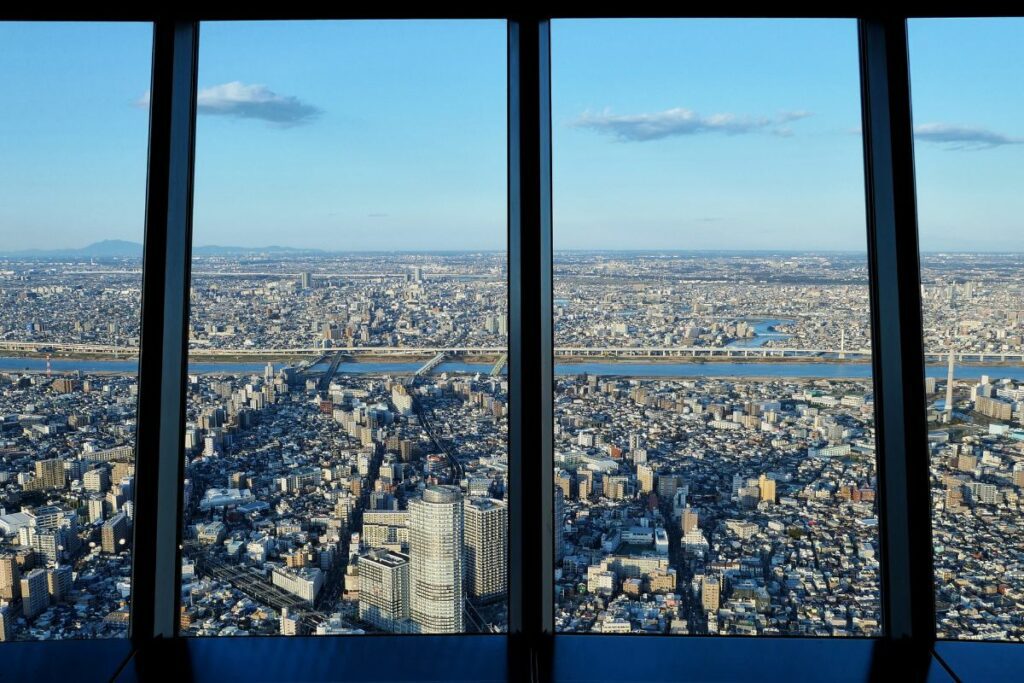
Who Might Not Enjoy Tokyo Skytree
Although Tokyo Skytree is on many visitors’ itineraries, some might want to skip this experience. Those who might find Tokyo Skytree less appealing include:
- People with a fear of heights: The Tokyo Skytree is the tallest structure in Japan. Going to the top of the tower can feel like standing on top of the world. It might be too high for some visitors to enjoy.
- Tourists looking for a Japanese experience: Many observatory towers exist in cities worldwide. The view from the top might not be too dissimilar from other towers.
- People who don’t like crowds or waiting in lines: Tokyo Skytree can get extremely busy sometimes, with long lines to use the elevator. Some of the window viewing sections can become crowded. People who dislike crowds may want to skip it for a more relaxing experience elsewhere.
Planning your Visit to Tokyo Skytree
If you are going to Tokyo Skytree, you might wonder where the tower is located, when you can visit it, and how to buy tickets. This guide will help you with all these questions.
Location of Tokyo Skytree and How to Get There
The Tokyo Skytree is located in the Sumida City Ward, close to the popular tourist destination of Asakusa, Tokyo.
The Tokyo Skytree is the key feature of Tokyo Skytree Town, also known as Tokyo Solamachi. This commercial complex opened in 2012 and features over 300 restaurants and shops, as well as a popular aquarium and planetarium.
There are various options when travelling to Tokyo Skytree by train. Tokyo Skytree Station and Oshiage Station are the most convenient methods. These stations are joined onto Tokyo Skytree Town, making the walk to Skytree very convenient.
The Tobu Skytree Line serves Tokyo Skytree Station. From Kita-senju station, you can ride the Tobu Skytree Line directly to Tokyo Skytree Station in 13 minutes. From Ueno Station, you can ride the Tokyo Metro Ginza line for 5 minutes to Asakusa Station, then switch to the Tobu Skytree Line and ride for another 3 minutes to Tokyo Skytree Station.
Oshiage Station is served by the Tokyo Metro Hanzomon Line and the Toei Asakusa Line. From Tokyo Station, use the JR Sobu Rapid Line for 8 minutes, switch at Kinshicho Station, and then ride the Tokyo Metro Hanzomon Line for 3 minutes to Oshiage Station. Ride the JR Yamanote Line from Shinjuku Station for 20 minutes to Shinagawa Station, then ride the Keikyu Main Line for 26 minutes to Oshiage Station.
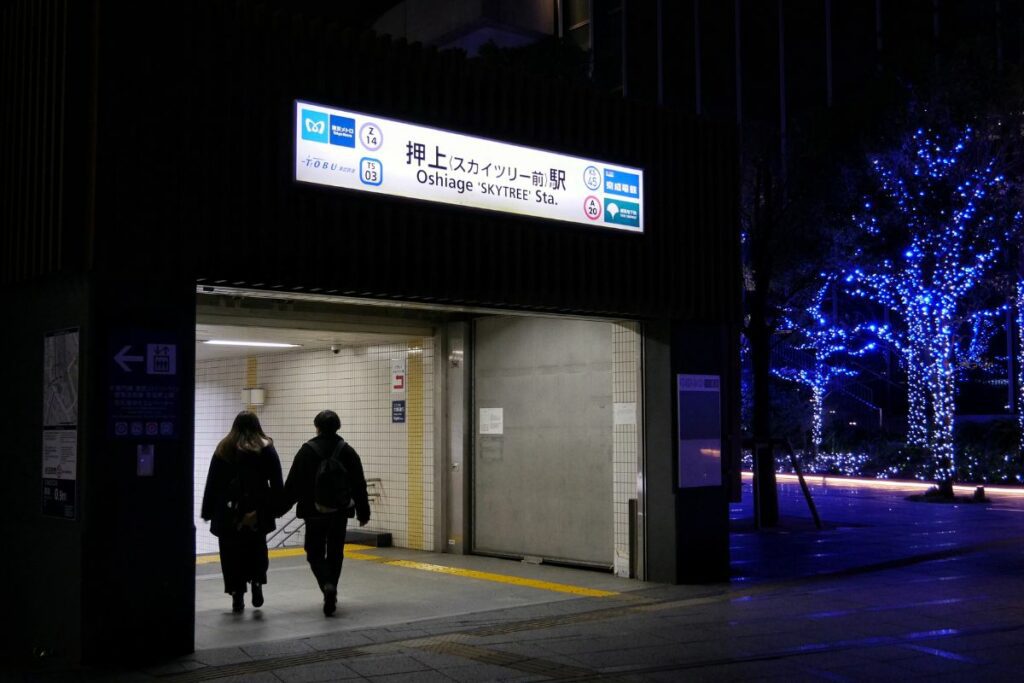
If you prefer to travel by bus, you can use the Skytree Shuttle. From Ueno Station, it takes 30 minutes and runs every 30-60 minutes for 220 yen. From Tokyo Disney, the bus takes 45-55 minutes, runs every hour and costs 800 yen. From Haneda Airport, the bus takes 50-70 minutes, runs every 1-3 hours and costs 940 yen.
How to Buy Tokyo Skytree Tickets
Various ticket options are available for Tokyo Skytree, including advance and same-day tickets. You can buy tickets on the Tokyo Skytree website and though online ticket agencies including Klook, Viator, and Rakuten Travel Experiences. You can’t buy advance tickets directly through the Skytree website.
Tickets bought in advance are cheaper. Also, purchasing before your visit allows you to select your date up to 30 days in advance and pick your time slot. The tickets vary in price from weekdays to holidays.
Same-day tickets go on sale on the Tokyo Skytree website the day of your visit or at the ticket counter on the 4th floor.
A Tembo Deck ticket allows access to the first observatory at 350 metres (1150 feet). A combo ticket allows visitors to go to both the 350-metre (1150 feet) and 450-metre (1480 feet) observatories.
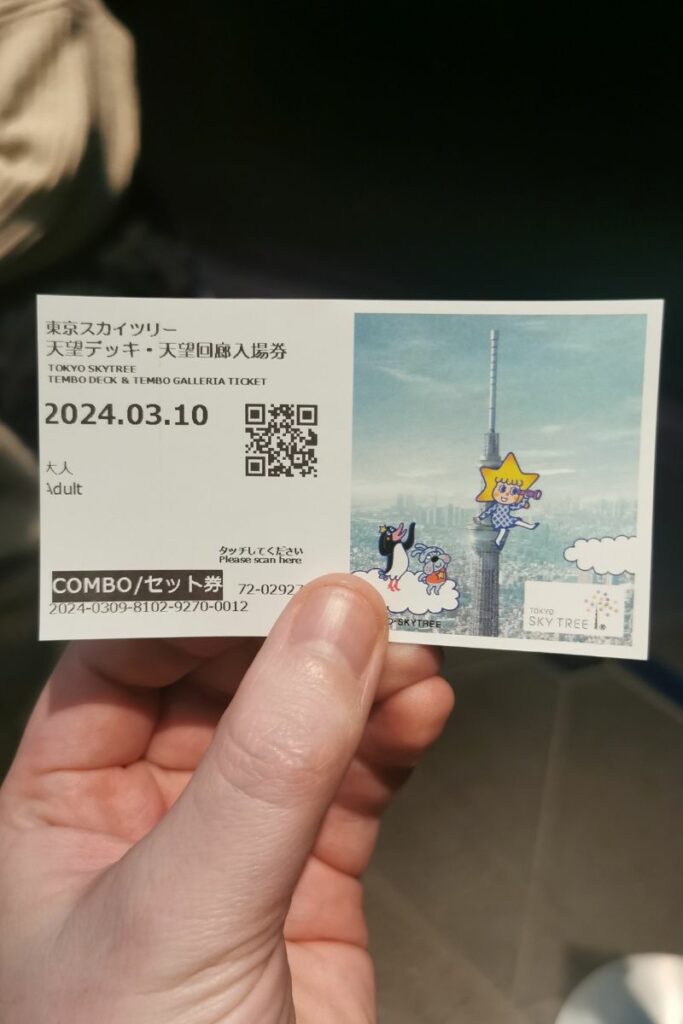
There are also three age price brackets. Ages 18 and up require an adult ticket. Ages 12 to 17 require a youth ticket. Ages 6 to 11 require a child ticket. Children 5 and under can enter for free with a guardian.
The Tokyo Skytree website and Klook ticket prices are:
- Adult Weekday Advance: Tembo Deck tickets are 1800 yen, and Combo Deck tickets are 2700 yen. Weekend tickets cost 200 yen more for the Tembu Deck and 300 yen more for the combo ticket. Buying the tickets in advance can save up to 400 yen for combo tickets.
- Youth Weekday Advance: Tembo Deck tickets are 1400 yen, and Combo tickets are 2150 yen. Weekend tickets cost 100 yen more for the Tembu Deck and 200 yen more for the Combo ticket. Buying youth tickets in advance can save up to 200 yen for combo tickets.
- Child Weekday Advance: Tembo Deck tickets are 850 yen, and Combo tickets are 1300 yen. Weekend tickets cost 50 yen more for the Tembu Deck tickets and 100 yen more for the Combo ticket. Buying a child ticket in advance can save up to 150 yen for Combo tickets.
Package Ticket Options
A variety of package ticket options are available from the Tokyo Skytree website. Prices vary based on whether it is:
- A Tembo Deck or Combo ticket.
- Whether it is for an adult, youth, or child.
- If it is a weekday or weekend ticket.
As an example, the standard prices for adult weekday tickets are as follows:
- Tembo Deck Ticket and Konica Minolta Planetarium Tenku Admission: 2990 yen
- Tembo Deck Ticket and Sumida Aquarium Admission: 3750 yen
- Tembo Deck Ticket and Small Worlds Tokyo Admission: 3950 yen
- Tembo Deck Ticket and TeamLab Planets Admission: 5000 yen
What to Wear to Tokyo Skytree
There are no clothing requirements to enter the Tokyo Skytree. However, if you plan to eat at the Sky Restaurant 634, you must dress appropriately.
The Sky Restaurant 643 is an upmarket eatery in the Tembo Deck of Tokyo Skytree. Its dress code is “smart casual.” Its website says to refrain from wearing T-shirts, shorts, jeans, cargo pants, capes, beanies, sportswear, and sandals.
The dress recommendations for men are a jacket and collared shirt, chino pants, slacks, trousers, leather shoes, and loafers. For women, they recommend a jacket, collared shirt, sleeveless dress, skirt, and trousers. Please dress to meet these standards if you wish to dine there.
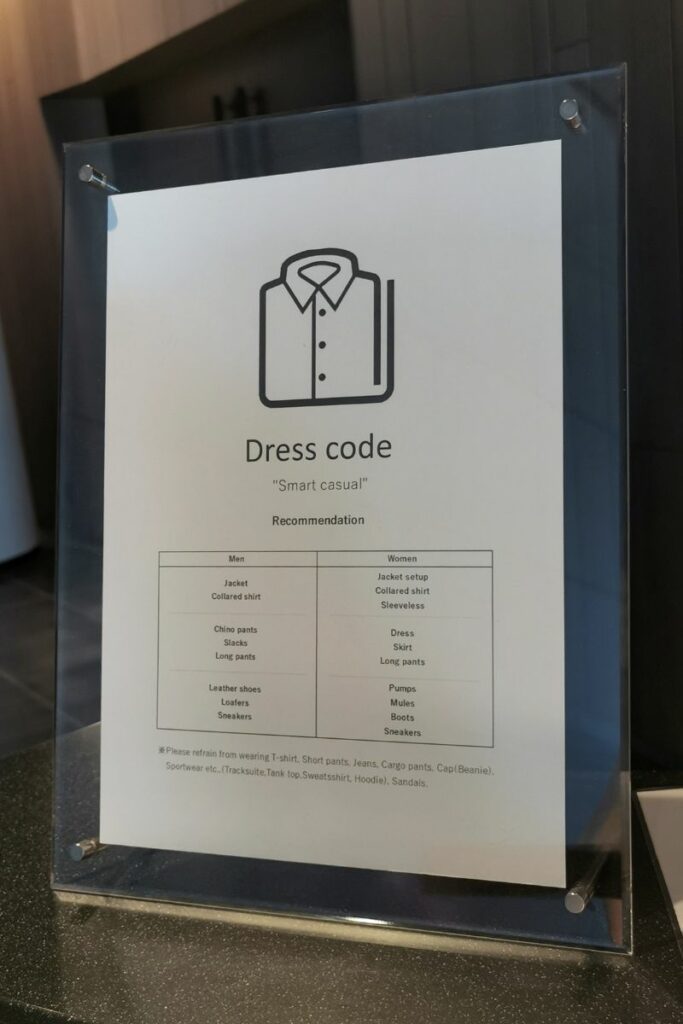
As the Skytree is indoors and out with the elements, you can dress comfortably with as many layers as you usually require. Oshiage Station and Tokyo Skytree Station are also part of Tokyo Skytree Town, so you won’t be required to walk outside from the station to the tower.
Tokyo Skytree Opening Hours
The Tokyo Skytree is open seven days a week from 10 am to 9 pm daily. However, this could change on public holidays, so it’s always best to check beforehand. The last admission for the Tembo Deck is at 8 pm, and for the Tembo Galleria, it is 8:20 pm.
The Skytree Cafe at the Tembo Deck is open from 10 am to 8:45 pm, with the last order being 8:15 pm.
The Sky Restaurant 634 is open for lunch from 12 pm to 4 pm. Dinner is between 5:30 pm and 9 pm, with the last order at 7 pm.
Observation Decks
When you arrive at the Tokyo Skytree entrance, you will find two entrances: one for advance ticket holders and one for purchasing same-day tickets.
The advance ticket entry will be for an assigned time. The time on my tickets (which I purchased from Klook) was 2 pm, which said to arrive between 2 and 3 pm. I arrived a little after 2 pm and followed the signs to enter.
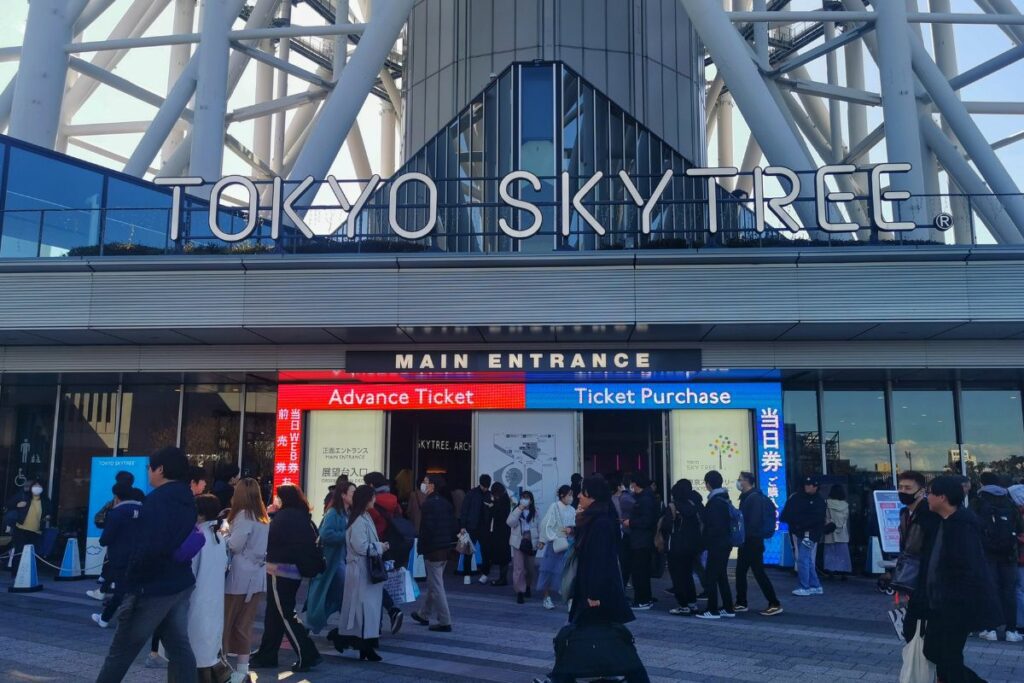
Electronic screens displayed the ticket times for visitors to enter. I queued for roughly 5 minutes before getting to the ticket machines. These machines allow you to scan your QR code or enter your booking number, and they will print a physical ticket.
After printing my ticket, I followed the signs to the elevator entrance. I waited in line for another 5 to 10 minutes. During this process, you go through a security check. They checked my bag to ensure I didn’t have any forbidden objects, and then I walked to the elevator.
Four different elevators are themed based on each season, and you will get a random selection of which one. I got the spring elevator, which played music and had flowers lighting up on the lift walls.
I was surprised at how fast the elevator travelled. I felt my ears pop and then promptly arrived at the Tembo Deck at 350 metres (1150 feet). The elevators have a capacity of 40 people and travel at 36 km/hr (22.4 mph). This makes it the fastest large-capacity elevator in Japan. It takes roughly 50 seconds from Level 4F to the Tembo Deck.
Tembo Deck
The Tembo Deck is the first stop on your Skytree journey, or your only stop if you didn’t purchase the Combo ticket.
I purchased the Combo ticket, so I planned to explore and enjoy the Tembo Deck before going to the next stop.
The Tembo Deck consists of three floors. Visitors will enter onto Floor 350 from the elevator. You can then use the stairs or escalators to navigate between Floor 345 and Floor 340. Each floor contains something different, so you will want to explore each individually.
- Floor 350 has the Skytree Cafe, a ticket booth for the Galleria Deck, a commemorative photo area, a high-resolution telescope, and an elevator to the Galleria Deck.
- Floor 345 has the Skytree Gift Shop, Skytree postbox, Skytree Restaurant 634, and an elevator from the Galleria Deck.
- Floor 340 has another Skytree Cafe, a glass floor, another commemorative photo area, and an elevator to take you back down to the bottom of the tower.
Views
As the Skytree is an observation deck, each floor is filled with floor-to-ceiling glass windows offering 360-degree views of Tokyo. Floor 350 offers the best chance to see unrestricted views from every angle, as the lower floors have sections used by cafes, a restaurant, and a shop. I found that going between each floor offered slightly different views, and the lower floors were sometimes less crowded. I could get closer to the glass and spend more time admiring the view and taking photos.
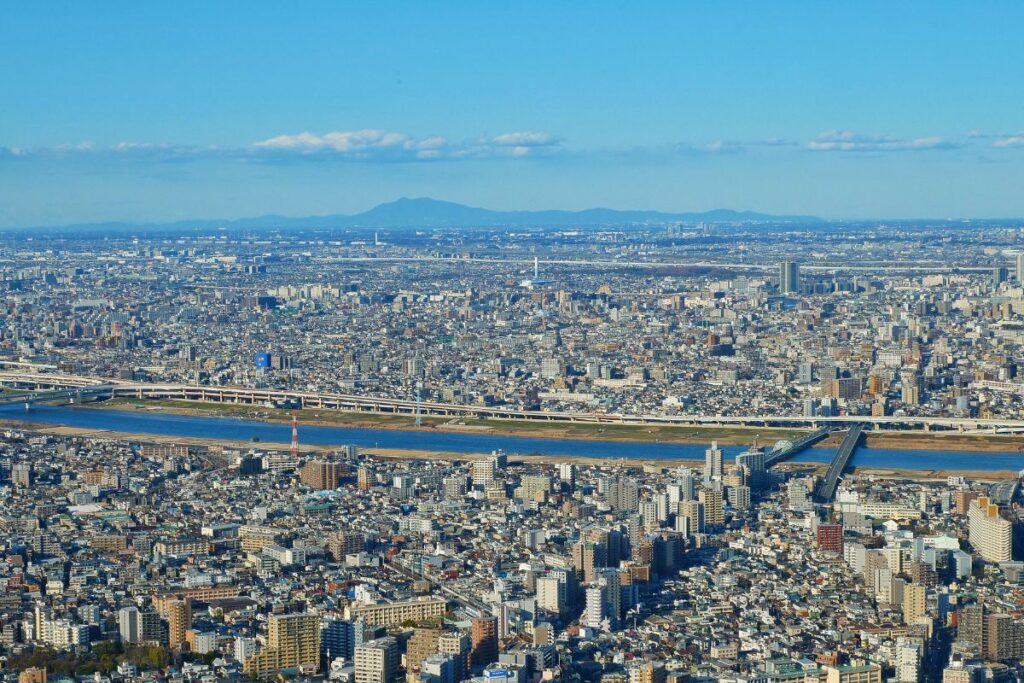
Photography
On each floor, a wall prevents you from getting too close to the glass, which makes it harder to take the best photos, especially at night. I usually place my camera right against the glass to capture the best photos to prevent any reflections. However, this wasn’t physically possible at the Tokyo Skytree, so I had to be more creative with my camera placement and zoom.
On Floor 350, visitors were standing at every window. After a short wait, they would usually move, and I could take over their spot to stand at the window.
When I went down to the lower floors, there were often windows completely free from customers. I used these to spend the most time setting up my camera and taking photos and videos without feeling rushed. This also allowed me to enjoy the view in a more peaceful and tranquil environment. There were also viewing benches on Floor 345, which I used to sit down and get a rest after lots of standing and walking.
Food
The highlight of my experience was the Skytree Cafe on Floor 340. I bought a cheesecake and a cafe latte for 1300 yen, which seemed like a fair price inside a top tourist attraction. I was given a tall seat at a table against the window.
Relaxing and enjoying my coffee and snack while overlooking Tokyo from 340 metres (1115 feet) was a truly wonderful experience. It was the best view I have ever had while eating. I must have sat there for about 45 minutes, and none of the staff tried to rush me off or tell me to leave.
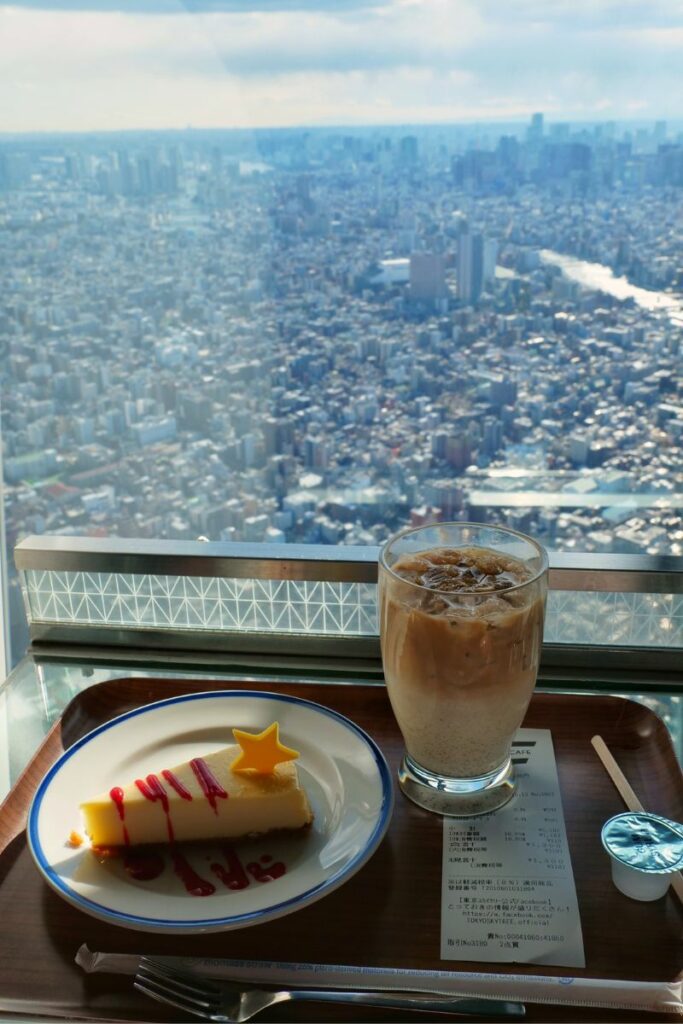
There is another smaller cafe on Floor 350. Both cafes sell similar items, including hot drinks, soft drinks, alcohol, cakes, snacks, appetisers, and soft-serve ice cream. The Floor 340 cafe also offered some larger food options, including a curry for 1200 yen and a hamburg steak for 1500 yen.
On Floor 345, there is the Sky Restaurant 634. This upmarket restaurant requires you to dress “smart casual” and serves lunch and dinner. It is more expensive than the cafe, with a lunch course costing 6000 yen or 8000 yen. Dinner courses cost 18,000 yen, 22,000 yen, or 30,000 yen. There is also a Teppanyaki option, which costs 12,500 yen for lunch and either 28,500 yen or 34,500 yen for dinner. The Sky Restaurant 634 takes reservations up to 2 months in advance.
Merchandise and Gift Options
If you want merch or gift options, the Skytree Shop on Floor 345 has you covered. They sell various items that I expected to see, such as coasters, pens, keychains, magnets, and models of the Skytree. Many of these items are exclusive to this shop.
There are also toys and plushes for kids featuring the Tokyo Skytree mascot, Sorakara-chan. There’s also a range of tasty souvenir snacks, such as chocolates and cookies shaped like the tower.
The Skytree post box is also on Floor 345. You can send a letter or postcard from here, which will be stamped as Skytree post. If you need a stamp, the gift shop has them available.
A commemorative stamp area is on Floor 350, near the elevator. This is free and a popular item for many visitors and Japanese locals. You can often find them in train stations and temples too.

If you need to get your own book or paper to stamp, there are free information pamphlets in stands across the Tembo Deck. On the second last page, there is a white empty box sized specifically for this stamp. It’s a great and free souvenir to take home with you. These information pamphlets are helpful and available in various languages, including Japanese, English, Korean, Chinese, French, and Spanish.
Glass Floor
Another highlight of the Tembo Deck is the glass floor. I almost missed this while exploring because it is near the elevator to take you back down. I only found it when I went hunting for it. It is located on Floor 340 and gives you a great view of looking down directly to the ground. I felt a little queasy as I watched people walking down below, but they looked like ants.
No Time Limits
There are no time limits for either floor, and I spent many hours on the Tembo Deck soaking in the views and capturing photos and videos before deciding to head to the Galleria.
Tembo Galleria
You ride the elevator from Floor 350 to access the Tembo Galleria. You will need a Combo ticket, or you can purchase a Galleria ticket from the ticket booth on this floor. Be warned: on the day I visited, a sign said that same-day tickets for the Galleria were completely sold out.
This is another high-speed elevator with a glass roof, so you can look up and see how quickly you are moving. When you leave the elevator, there is another optional paid photo spot, where a photographer takes a picture of you with the Tokyo city through the window as a backdrop.
The Tembo Galleria is 450 metres (1480 feet) and offers a higher, more birds-eye viewing of Tokyo. The Galleria observatory is on two floors, 450 metres (1480 feet) and 445 metres (1460 feet).
Instead of the stairs and escalators that are used in the Tembo Deck to navigate between floors at the Galeria, you walk up and down a slanted walkway that goes 360 degrees around the tower.
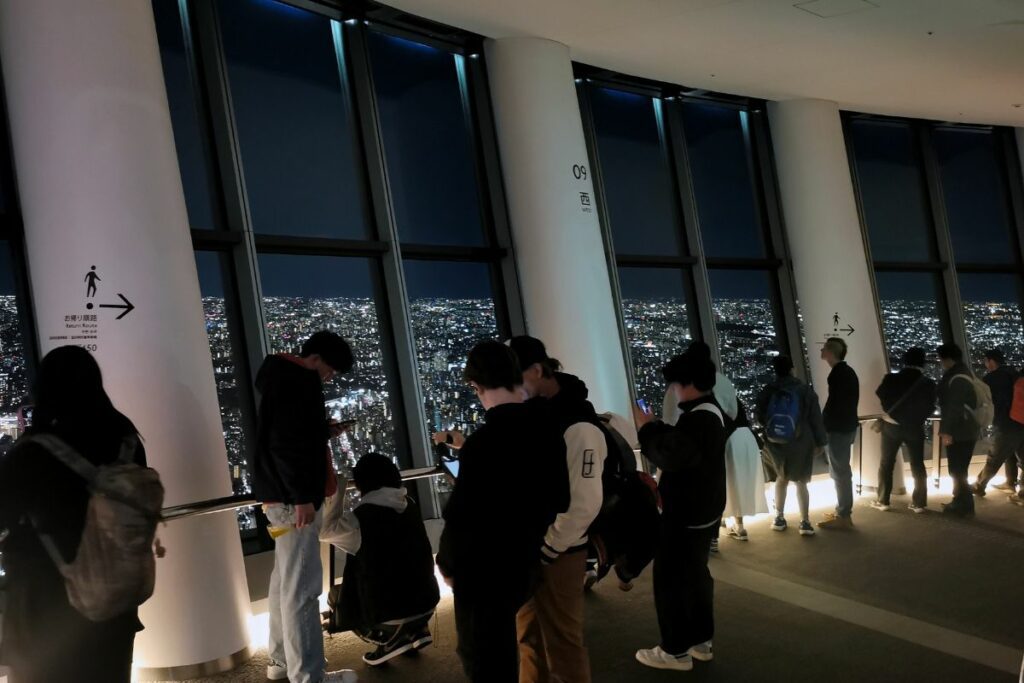
The Galleria is less crowded than the Tembo Deck and offers a more unrestricted 360-degree view, as no cafes or shops take up window space. I noticed more photographers in this observatory using cameras with large lenses to capture the best photos possible. The Tembo Galleria’s windows are less restricted, offering more angles and options for shooting photos.
From both observatories, you can see just as far into the distance. On clear days, you can spot Mount Fuji from either. However, the Tembo Galleria offers a more unique angle at the buildings below, which photographers can make the most of. Keep in mind that this deck is extremely high. If you want to get the best photos possible, you will need a camera with a large zoom lens, as most phone cameras will struggle to do this view justice.
Also on Floor 450 is the Sorakara Point, which is in the middle of the tower so it doesn’t obstruct any window space. At the Sorakara point, there is a space surrounded by light and glass. The space is supposed to give you a three-dimensional view that makes you feel like you are floating. I didn’t experience this feeling, but I did think that it looked cool, and I saw many visitors taking photos inside.
Is the Tembo Galleria worth the extra admission price? I say yes if you are a photographer or really like high observatories. The views from here are incredible, and with a camera with a decent zoom, you can capture some fantastic pictures. However, if you are just a casual tourist and don’t have a fancy camera, the view from both observatories isn’t too dissimilar.
If you are considering visiting the Tembo Galleria, buy the advance combo ticket. This will not only save you money but also guarantee your entry. They may already be sold out if you wait to buy a same-day ticket from the Tembo Deck.
Views at Tokyo Skytree
The view from Tokyo Skytree is breathtaking, so you’ll want to spend your time wisely capturing the best photos and enjoying the views.
Going earlier in the morning will give you the clearest views from the sky and smaller crowds. Going in the afternoon and staying up there will allow you to see Tokyo during the day and at sunset.
I spent most of my time in the Tembo Deck. During the day, this observatory offered spectacular views.
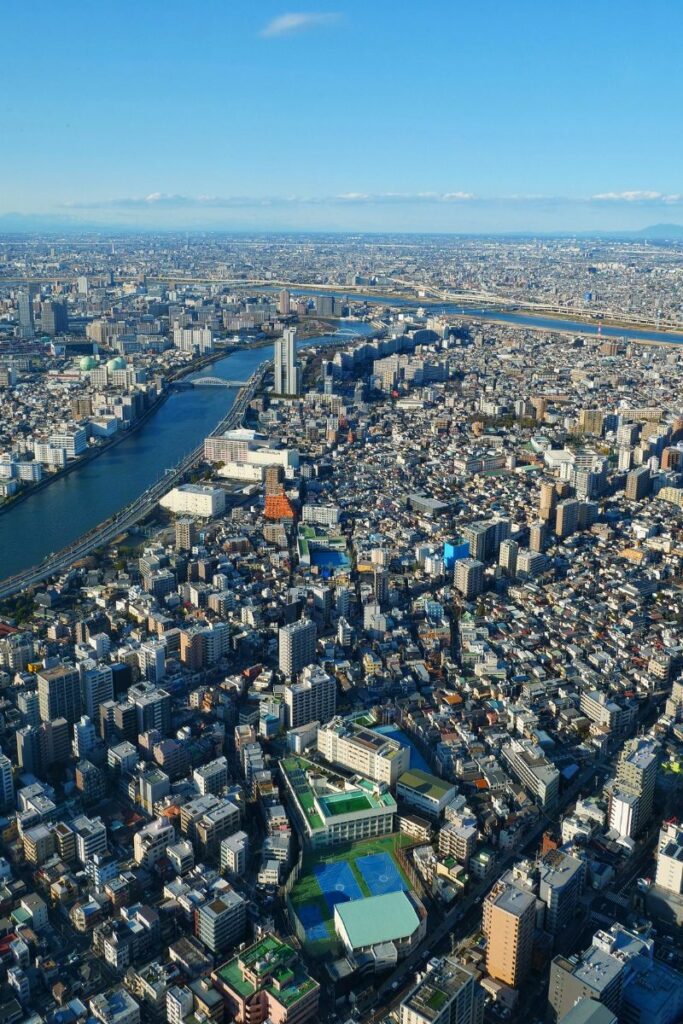
I spent a long time going between floors and trying each direction to see the difference and view and capture photographs. While it is still bright, you can see as far as the horizon, and it feels like you are standing in the clouds. This also allows you to spot distinct Tokyo landmarks such as Tokyo Tower, The Tokyo Dome, and the temples of Asakusa.
The Skytree Cafe also offers stunning views, and I sat here during sunset. I enjoyed watching the sunset over Tokyo while I relaxed, ate a cake and drank some coffee. You are a bit further back from these windows, though, so you will capture some reflections if you take photos.
I went up to the Tembo Galleria when it was dark, and the lights below started to turn on. This allowed me to look down on the city as the roads and buildings lit up like a computer circuit. While this view was great, and I could also enjoy seeing the Tokyo Tower lit up from here, I think it was partly a mistake.
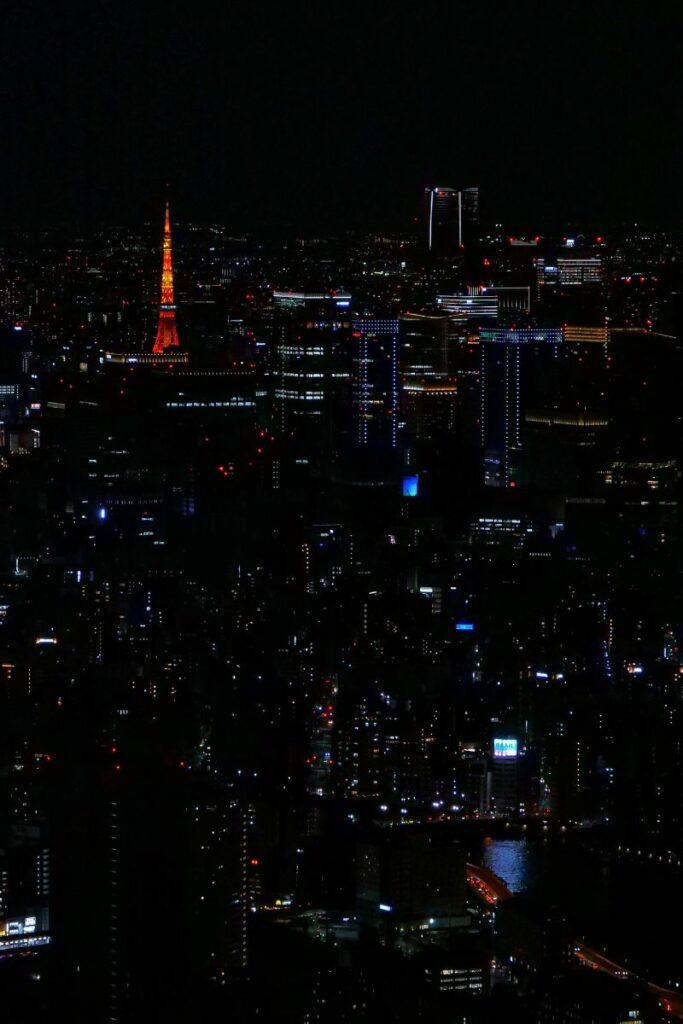
It’s much harder to spot buildings and see the details below when it’s so dark outside. If I were to visit again, I would go to Tembo Galleria while it was still daylight to see further and look for more buildings or locations I knew.
I brought my Lumix GH5 with a 12-60mm/F3.5-5.6 lens to capture the best photos, but it wasn’t strong enough. For Tokyo Tower, this lens was fine. But for Tokyo Skytree, you need a better zoom to do the photographs justice.
Tips and Tricks for Tokyo Skytree
After visiting the Tokyo Skytree and spending many hours exploring the city’s tallest tower, I will offer some tips and tricks that I learned along the way.
Crowds
Tokyo Skytree is a very popular tourist destination, attracting over 10,000 visitors per day. It is open seven days a week, but weekdays are quietest if you want to beat the crowds.
Weekends and holidays should be avoided unless they are your only option. It is also the least busy in the early morning or late at night before closing.
Views
If you are on the Tembo Deck on Floor 350 and are having trouble getting a good viewing spot at the window, try going to Floor 345 or Floor 340. These floors also have large viewing windows and tend to be much quieter.
Prohibited Items
Tokyo Skytree has a list of forbidden items that you can’t bring on your visit. These include scissors, swords, knives, hammers, tripods, baseball bats, golf clubs, bows and arrows, scooters, skateboards, guitars, suitcases, matches, fireworks, party poppers, pets (including caged animals), drones, mobility scooters, radio equipment, drinks in cups, drinks without a resealable lid, and headgear covering the full face.
Before you enter the lifts, you will go through a security and bag check.
Coin Lockers
If you bring any forbidden items, you can store them in one of the coin lockers. The lockers are on floors B3F, 1F, 2F, 3F, and 4F. They cost 1000 yen for extra large, 800 yen for large, 600 yen for medium and 500 yen for small.
If you have any baggage, you can check them at the baggage storage counter on 1F for a fee of 500 yen (US$ 3.30) per item.
Toilets
There are multiple toilets available throughout the whole Tokyo Skytree. These are available on 1F, 4F, 5F, Floor 350, Floor 340, and Floor 450.
Accessibility
There are also accessible toilets available on every floor. There are nursing rooms on 1F and 4F. And there is also a prayer space of 1F.
Tokyo Skytree has priority elevators for wheelchairs and strollers to take you to the Tembo Deck. Seeing-eye dogs, hearing assistance dogs, and service dogs are permitted in Tokyo Skytree.
Information Counters and Language Support
There are information counters on 3F Tower Yard and 1F East Yard. These can help visitors with English-language support.
Free guide pamphlets are also available in many languages, including English, Chinese, Spanish, Italian, French, and Korean. These guides contain maps, information about the tower, floor guides, and a panoramic guide to help you spot famous Tokyo Locations. They are spread around the Tokyo Skytree on stands, so keep an eye out for them.
Taking Photographs of Tokyo Skytree
Tokyo Skytree doesn’t just look beautiful from the top, it also looks great as the main subject in photos.
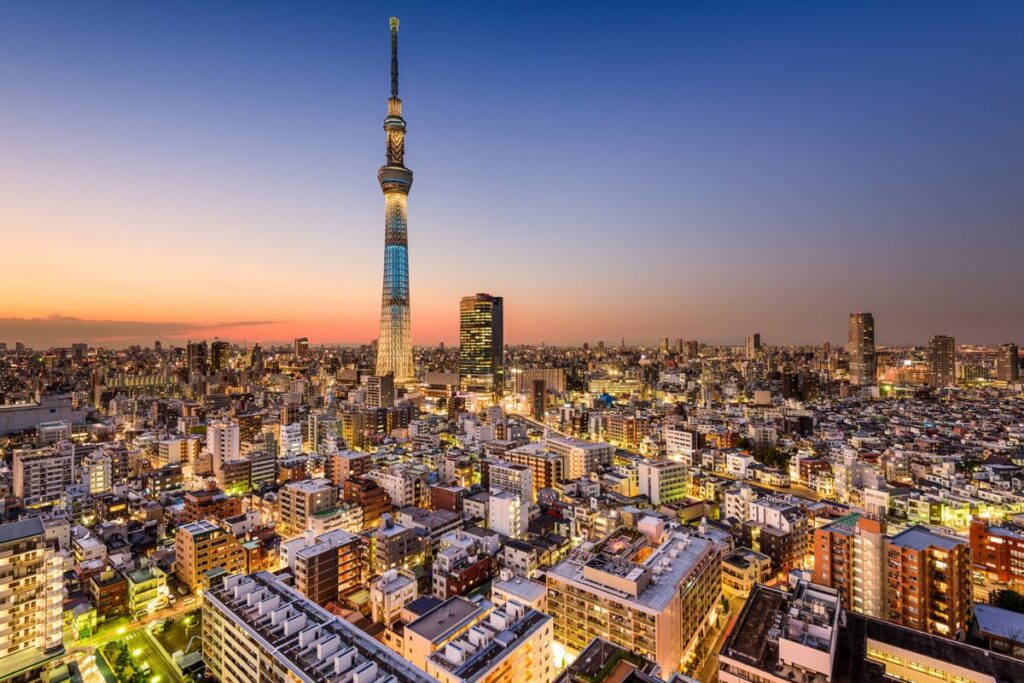
One of the best places I captured the tower was from the river near the Azuma-Bashi bridge. This is located right outside of Asakusa Station exit 4. You can take photos of the tower next to the Asahi building, which is topped with the Asahi Golden Flame. Some visitors refer to this as the Golden Turd.
A quick 5-minute walk from Tokyo Skytree Town will take you to the Jukken Bridge. This offers a great photo op of the tower straight on and unrestricted, with its reflection in the river below.
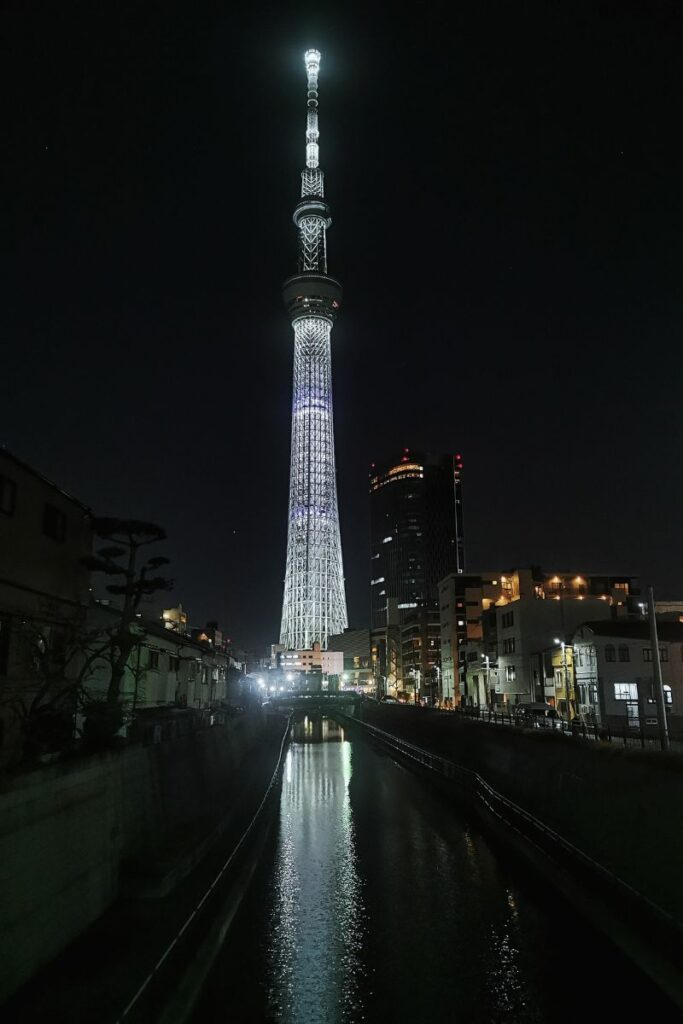
As Tokyo Skytree is huge, take a stroll around the streets of Asakusa and Sumida, and you will find plenty of locations to shoot interesting photos.
Nearby Attractions to Tokyo Skytree
If you are travelling to Tokyo Skytree, there is plenty more to see and do in the area.
Tokyo Skytree Town
First up is Tokyo Skytree Town, a huge shopping and entertainment complex featuring over 300 shops and restaurants to suit everyone’s needs. These include the Hello Kitty shop, a Pokemon Center, an Ultraman shop, and a Donguri Republic specialising in Studio Ghibli merchandise.
Also, Tokyo Skytree Town has a highly-rated aquarium and planetarium, which would be a great addition before or after your trip up the tower.
If you are feeling peckish, there are numerous options to keep you happy. Some highlights include the Moomin House Cafe, which features food and decor themed after the popular characters. If you are craving a burger, the famous gourmet burger chain Kua’aina has a shop here selling Hawaiian-style burgers.
If you head up to the 6th and 7th floor, you will find a range of Japanese restaurants selling everything from Unagi, to sushi, to okonomiyaki and ramen. Rokurinsha is a delicious ramen restaurant that usually has a line from locals and tourists as they are known to be extremely tasty. Hitsumabushi Nagoya Bincho is a restaurant that specialises in Unagi bowls. They serve freshwater eels grilled over a fire and then coated with their signature secret sauce.
Surrounding Area
From the Tokyo Skytree Town, you can also catch the ever-popular Hop-on Hop-off open-top bus. This red double-decker bus goes all around Asakusa and Sumida before travelling around Tokyo, giving you unique views and insight into this massive city.
If buses feel too modern, why not try one of the famous rickshaw rides? Head to Asakusa station, and right outside of it, you will find streets lined with the rickshaws and the drivers, both male and female. These rickshaws are more than just a bit of fun; many drivers speak English and can offer information about the local area. Plus, it makes for a great photo op.
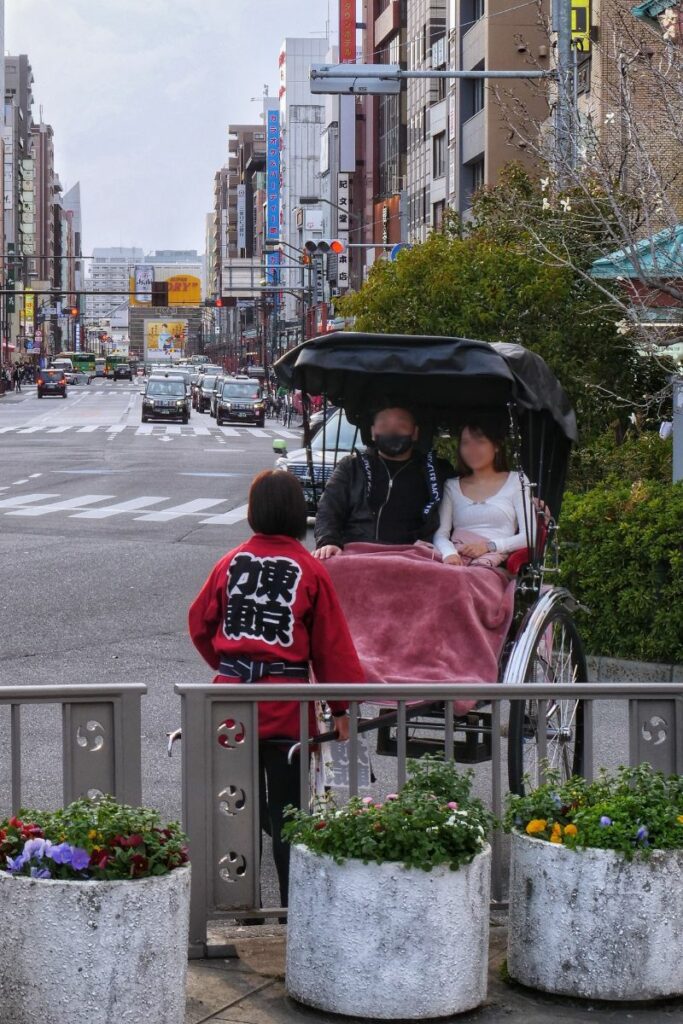
My Final Thoughts on Tokyo Skytree
Tokyo has plenty of observatories, and more have been popping up over recent years. There’s the classic Tokyo Tower, Shibuya Sky, and even the Tokyo Metropolitan Government Building.
Tokyo Skytree’s main selling point is its height. Nothing else in Tokyo comes even close to it. Most visitors choose between Tokyo Tower and Tokyo Skytree. Before giving my opinion of which one is best, I’ll first touch on the pros and cons.
Tokyo Skytree observation decks are 350 metres (1150 feet) and 450 metres (1480 feet), and Tokyo Tower observation decks are 150 metres (490 feet) and 250 metres (820 feet). Tokyo Skytree has higher views and is almost double the height of Tokyo Tower. This gives you a birds-eye view of the city and an understanding of Tokyo’s scale.
However, the view from Tokyo Tower is equally impressive in some ways and even more impressive in others. As Tokyo Tower is more central to the city and isn’t as high, you can appreciate the architecture and beauty of the other city skyscrapers. I also think that Tokyo Tower makes capturing good photos of the city and its lights easier without being too high that the lights turn into small dots.
If you can only visit one … It’s a tough choice, but I’d say Tokyo Tower. The views are equally impressive, and it is easier to capture photos. Plus, Tokyo Tower is less crowded.
However, if you are looking for sheer height, Tokyo Skytree will tick that box for you. It feels like you are standing on top of the world, as it’s among the highest views you might ever see. And if you have a camera with an excellent zoom, you should still be able to capture great photos.
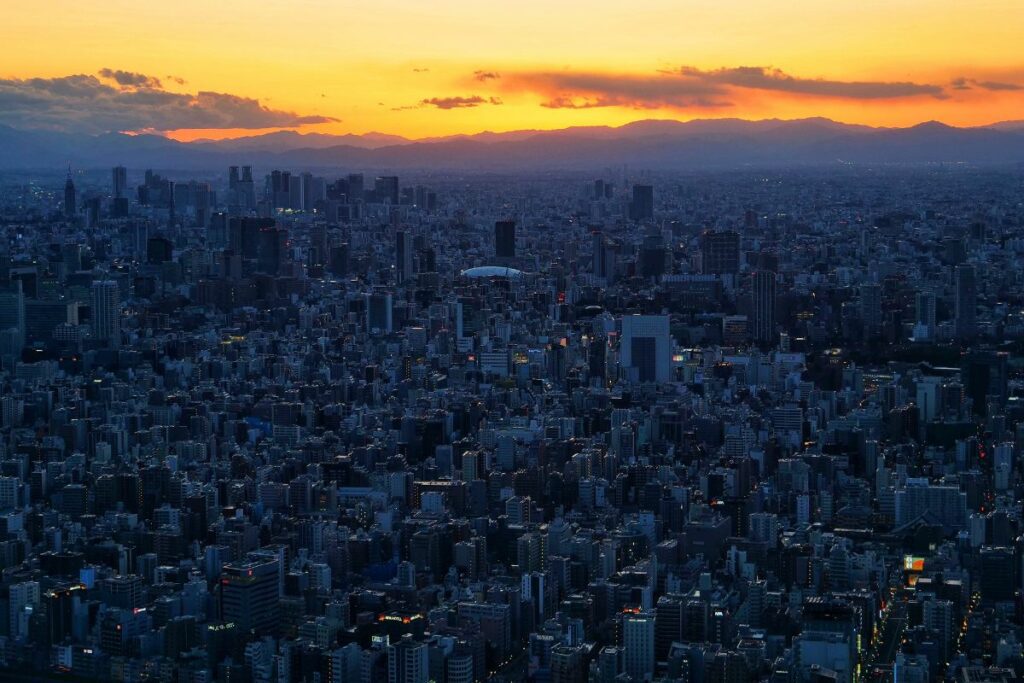
Frequently Asked Questions about Tokyo Skytree
If you have decided to visit Tokyo Skytree, you might have some final burning questions or worries, and I’m here to address them for you.
- Check out the views from the tallest building in Japan.
- See the Tokyo cityscape from a perspective that no other tower can offer.
- Lots of different ticket options available.

Join the Japan Travel Planning Facebook Group or Discord Server
You are also welcome to join our Japan Travel Planning Facebook Group and our Japan Travel Planning Discord Server – they are great resources to enable you to ask questions about your upcoming trip to Japan!
Disclaimer: This article contains affiliate links. If you book after clicking on one of these links then we may receive a small commission at no extra cost to you.

